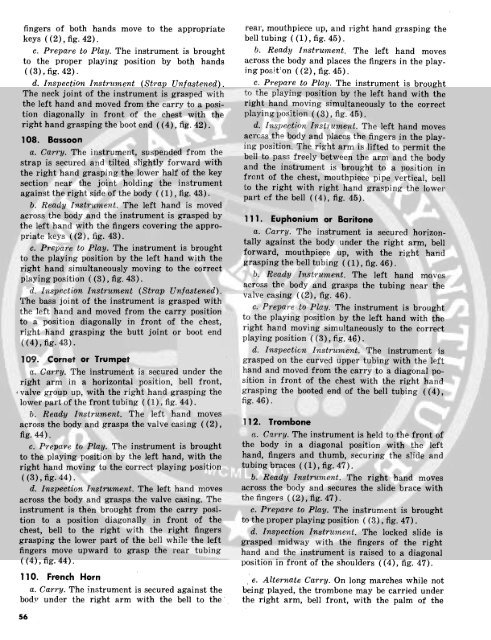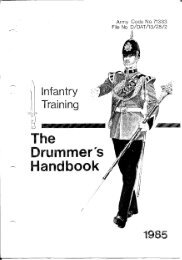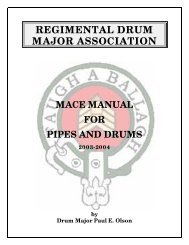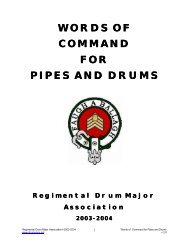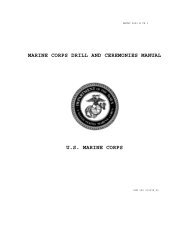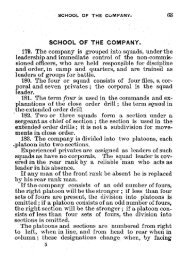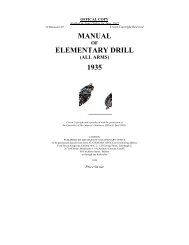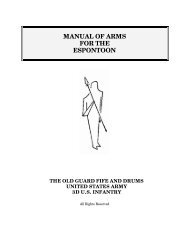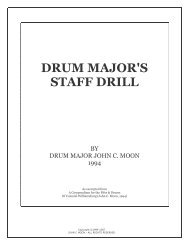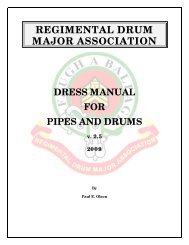The Military Band - Regimental Drum Major Association
The Military Band - Regimental Drum Major Association
The Military Band - Regimental Drum Major Association
Create successful ePaper yourself
Turn your PDF publications into a flip-book with our unique Google optimized e-Paper software.
fingers of both hands move to the appropriate rear, mouthpiece up, and right hand grasping the<br />
keys ((2), fig. 42). bell tubing ((1), fig. 45).<br />
c. Prepare to Play. <strong>The</strong> instrument is brought b. Ready Instrument. <strong>The</strong> left hand moves<br />
to the proper playing position by both hands across the body and places the fingers in the play-<br />
((3), fig. 42). ing positfon ((2), fig. 45).<br />
d. Inspection Instrument (Strap Unfastened). c. Prepare to Play. <strong>The</strong> instrument is brought<br />
<strong>The</strong> neck joint of the instrument is grasped with t;o the playing position by the left hand with the<br />
the left hand and moved from the carry to a posi- right hand moving simultaneously to the correct<br />
tion diagonally in front of the chest with the playing position ((3), fig. 45).<br />
right hand grasping the boot end ((4), fig. 42). d. Inspection Instrument. <strong>The</strong> left hand moves<br />
108. Bassoon<br />
a*8. Carry.n Teisrmtsupndfo th<br />
a. Carry. <strong>The</strong> instrument, suspended from the<br />
strap is secured and tilted slightly forward with<br />
across the body and places the fingers in the play-<br />
ing position. <strong>The</strong> right arm is lifted to permit the<br />
bell to pass freely between the arm and the body<br />
and the instrument is brought to a position in<br />
the right hand grasping the lower half of the key front of the chest, mouthpiece pipe vertical, bell<br />
section near the joint holding the instrument to the right with right hand grasping the lower<br />
against the right side of the body ( (1), fig. 43).<br />
b. Ready Instrument. <strong>The</strong> left hand is moved<br />
part of the bell ((4), fig. 45).<br />
across the body and the instrument is grasped by 111. Euphonium or Baritone<br />
the left hand with the fingers covering the appropriate<br />
keys ((2), fig. 43).<br />
a. Carry. <strong>The</strong> instrument is secured horizon-<br />
tally against the body under the right arm, bell<br />
c. Prepare to Play. <strong>The</strong> instrument is brought<br />
to the playing position by the left hand with the<br />
forward, mouthpiece up, with the right hand<br />
right hand simultaneously moving to the correct<br />
playing posiion((3,b.<br />
d. Inspection Instrument (Strap Unfastened).<br />
<strong>The</strong> bass joint of the instrument is grasped with<br />
Ready Instrument. <strong>The</strong> left hand moves<br />
across the body and grasps the tubing near the<br />
valve casing ((2), fig. 46).<br />
the left hand and moved from the carry position<br />
to a position diagonally in front of the chest,<br />
c. Prepare to Play. <strong>The</strong> instrument is brought<br />
to the playing position by the left hand with the<br />
right hand grasping the butt joint or boot end<br />
((4),fig. 43).<br />
right playing hand position moving ((3), simultaneously fig. 46). to the correct<br />
playing position ((3), fig. 46).<br />
d. Inspection Instrument. <strong>The</strong> instrument is<br />
109. Cornet or Trumpet grasped on the curved upper tubing with the left<br />
a. Carry. <strong>The</strong> instrument is secured under the hand and moved from the carry to a diagonal poright<br />
arm in a horizontal position, bell front, sition in front of the chest with the right hand<br />
, valve group up, with the right hand grasping the grasping the booted end of the bell tubing ((4),<br />
lower part of the front tubing ((1), fig. 44).<br />
b. Ready Instrument. <strong>The</strong> left hand moves<br />
fig. 46).<br />
across the body and grasps the valve casing ((2), 112. Trombone<br />
fig. 44). a. Carry. <strong>The</strong> instrument is held to the front of<br />
c. Prepare to Play. <strong>The</strong> instrument is brought the body in a diagonal position with the left<br />
to the playing position by the left hand, with the hand, fingers and thumb, securing the slide and<br />
right hand moving to the correct playing position tubing braces ((1), fig. 47).<br />
((3), fig. 44). b. Ready Instrument. <strong>The</strong> right hand moves<br />
d. Inspection Instrument. <strong>The</strong> left hand moves across the body and secures the slide brace with<br />
across the body and grasps the valve casing. <strong>The</strong> the fingers ((2), fig. 47).<br />
instrument is then brought from the carry posi- c. Prepare to Play. <strong>The</strong> instrument is brought<br />
tion to a position diagonally in front of the to the proper playing position ( (3), fig. 47).<br />
chest, bell to the right with the right fingers d. Inspection Instrument. <strong>The</strong> locked slide is<br />
grasping the lower part of the bell while the left grasped midway with the fingers of the right<br />
fingers move upward to grasp the rear tubing hand and the instrument is raised to a diagonal<br />
((4), fig. 44). position in front of the shoulders ((4), fig. 47).<br />
110. French Horn e. Alternate Carry. On long marches while not<br />
a. Carry. <strong>The</strong> instrument is secured against the being played, the trombone may be carried under<br />
body under the right arm with the bell to the the right arm, bell front, with the palm of the<br />
56


